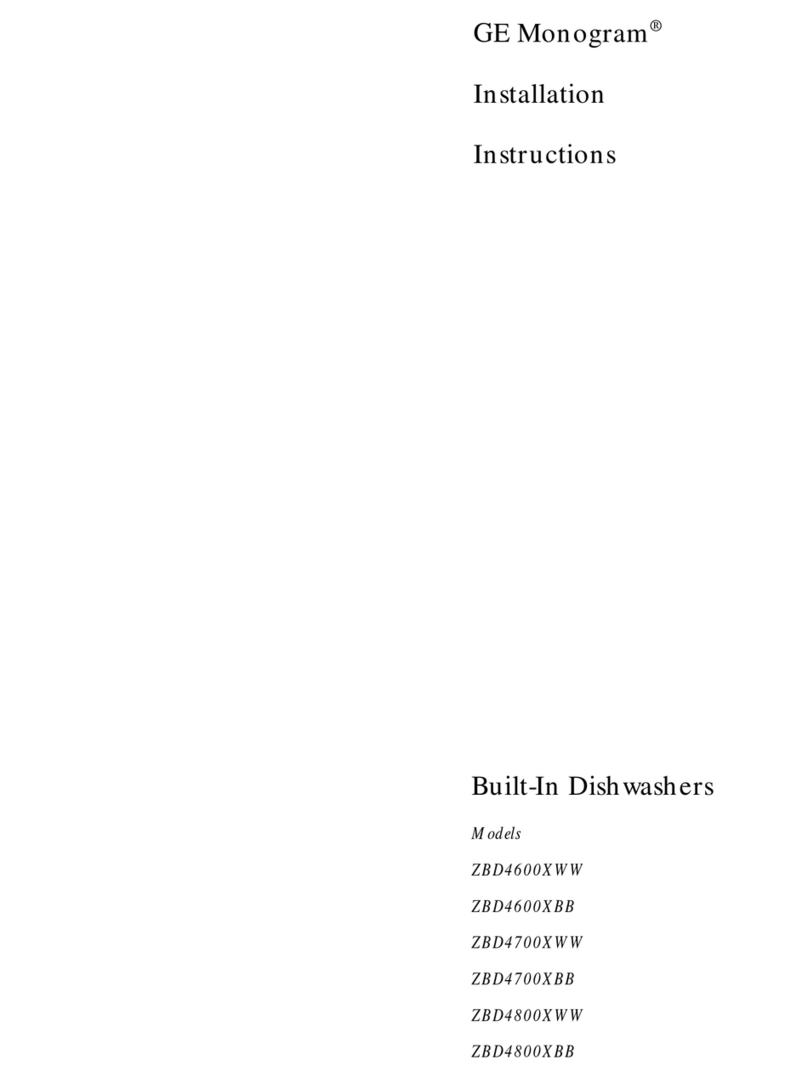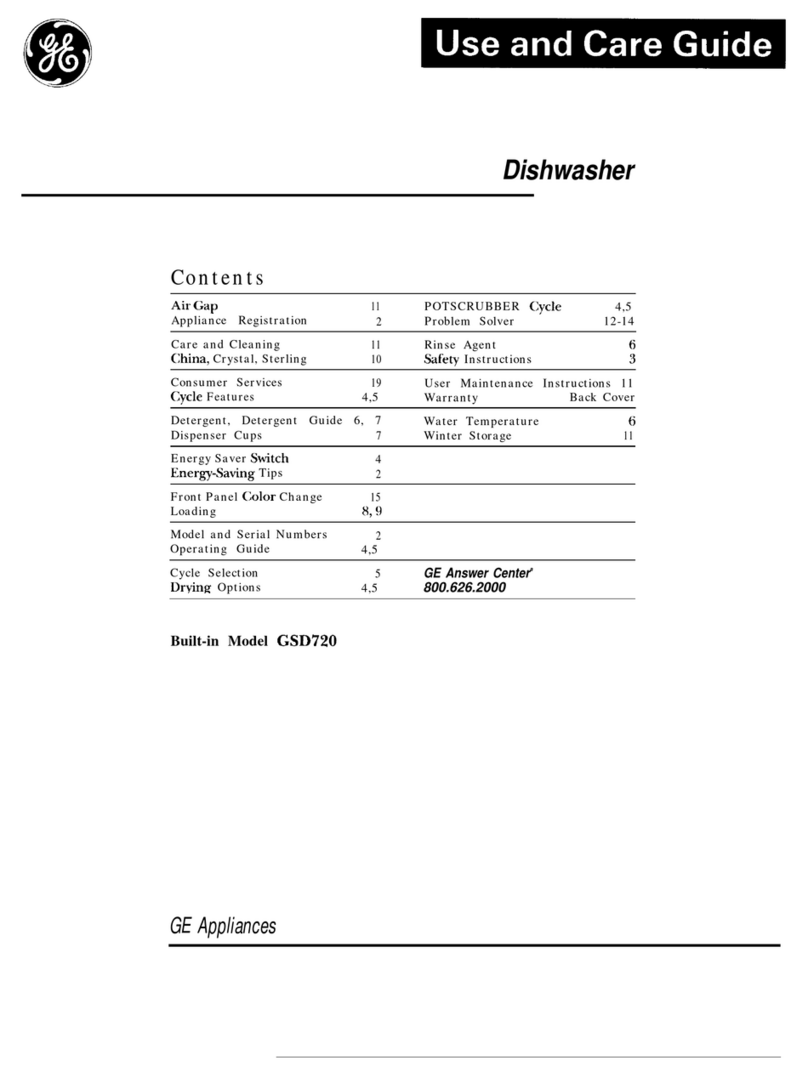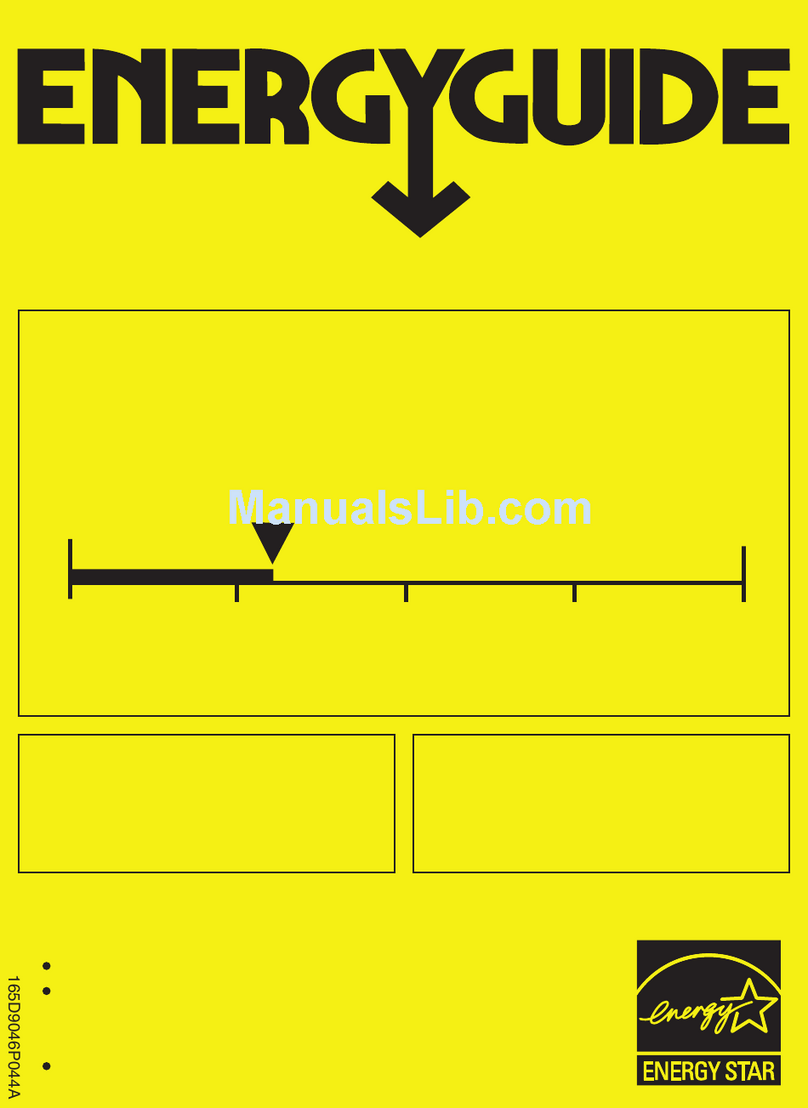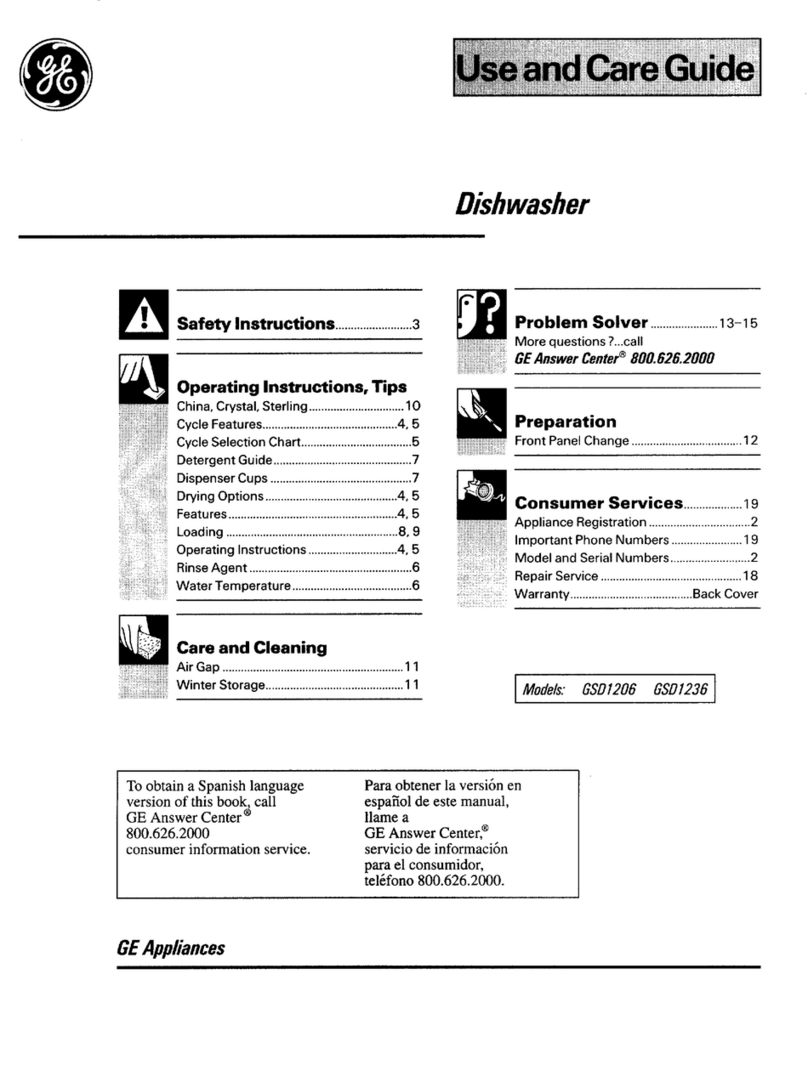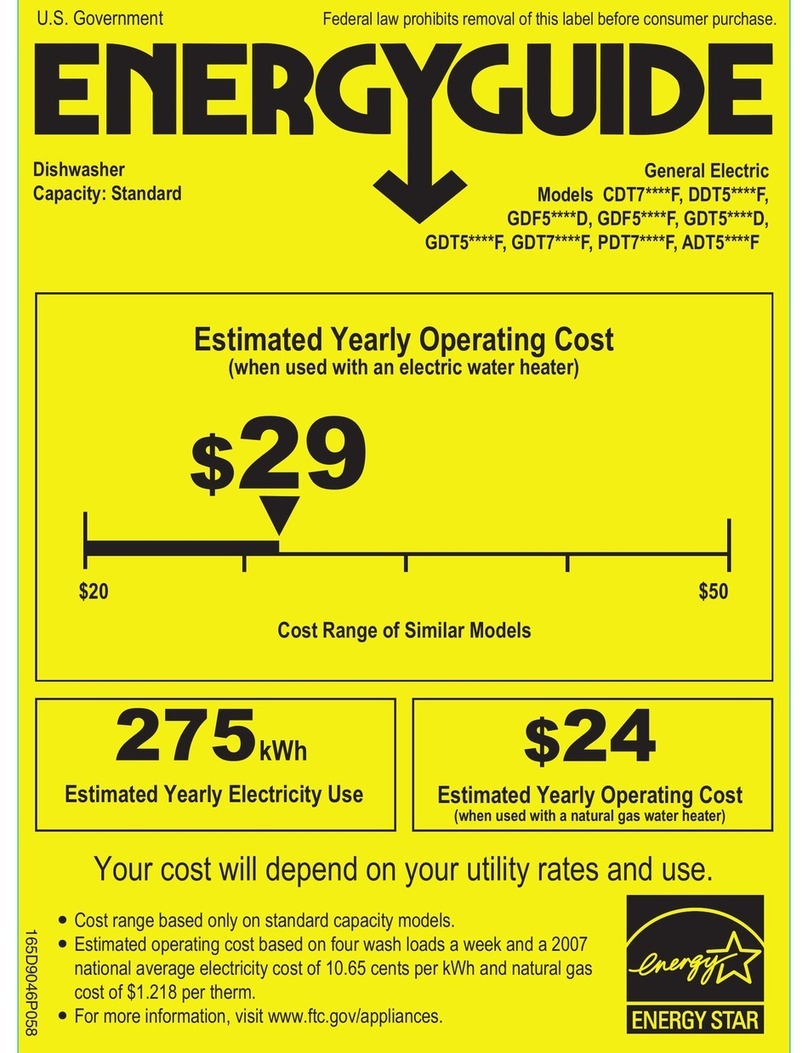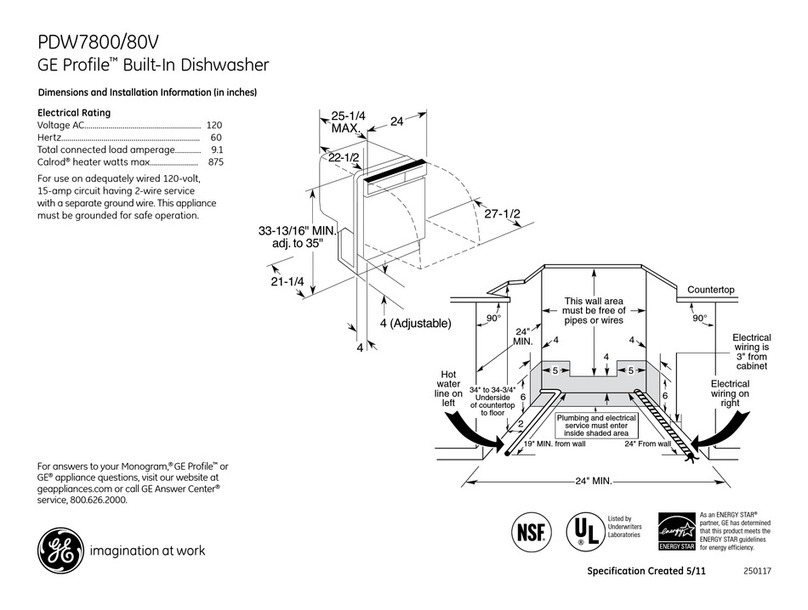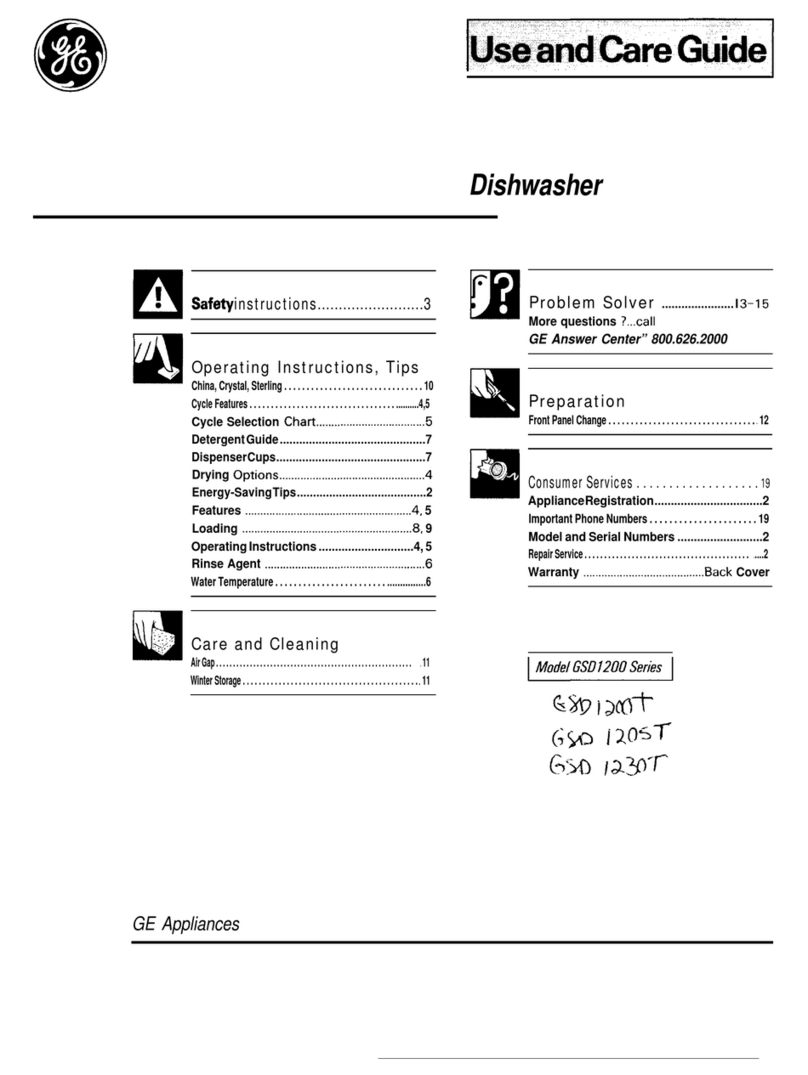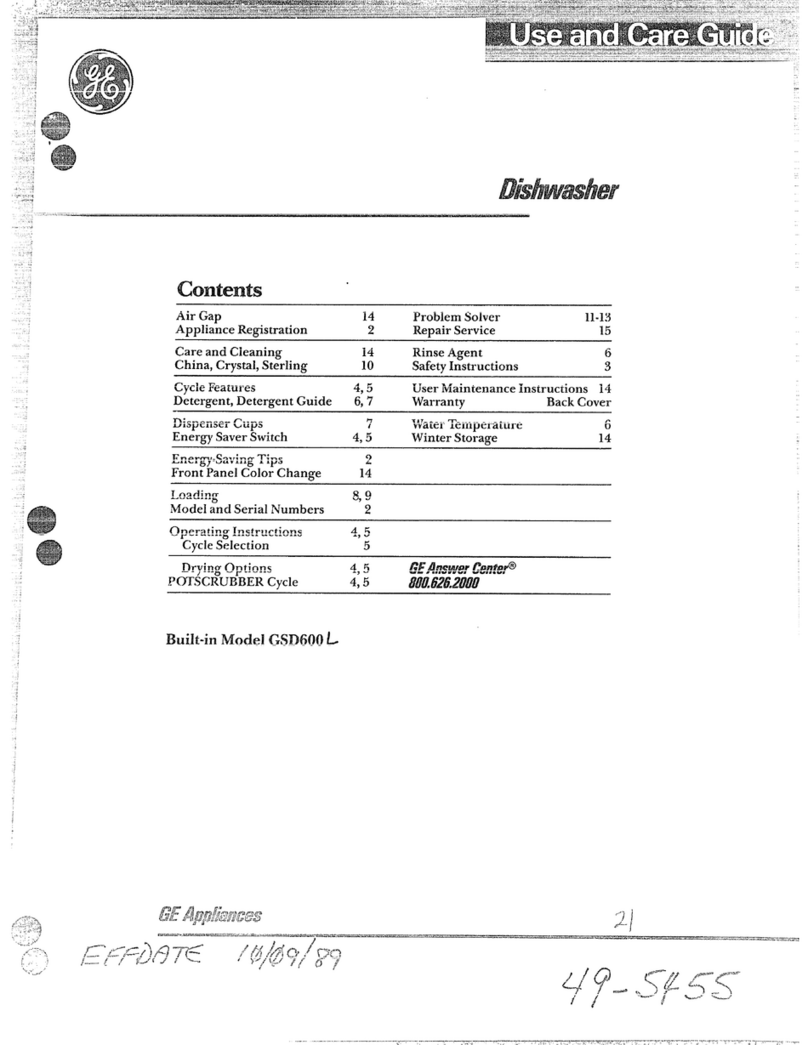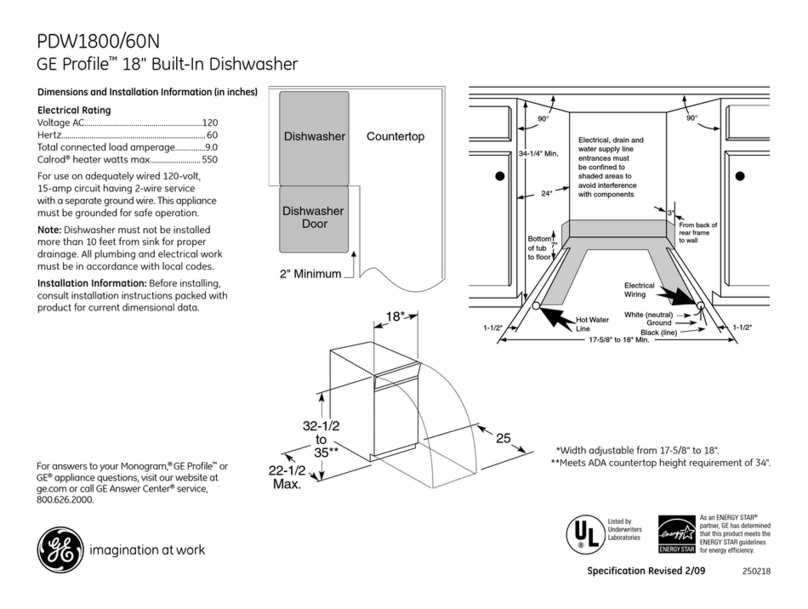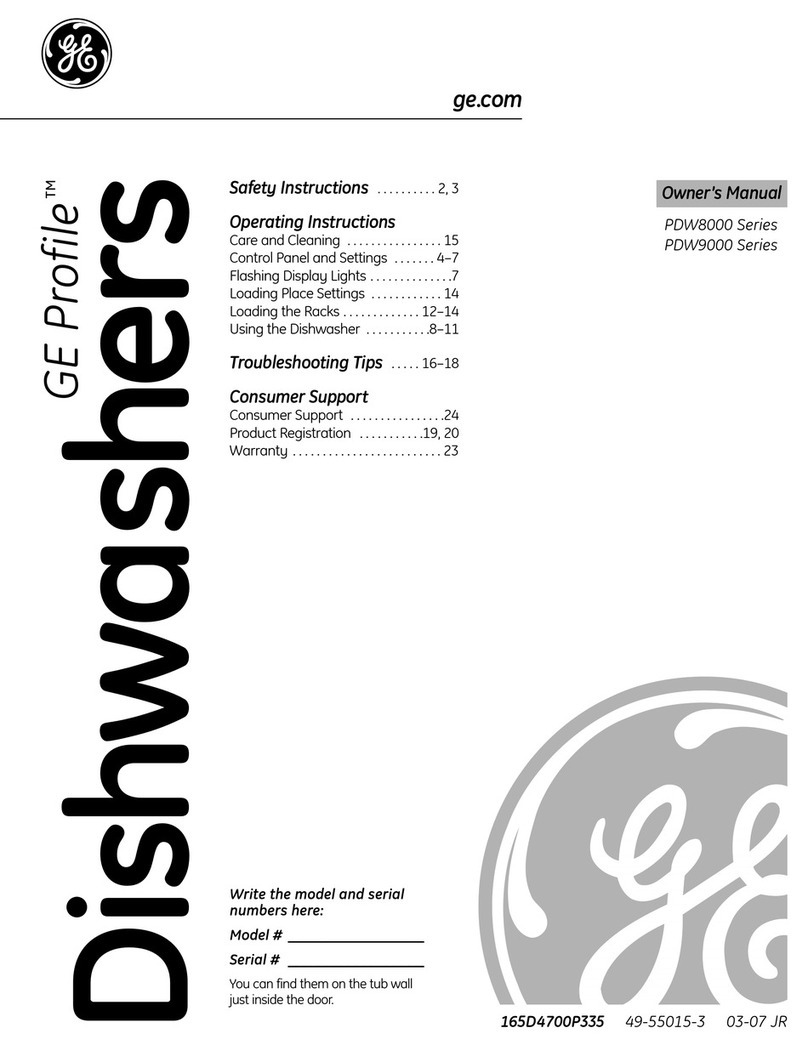GE CDWT980RSS - Cafe 24" Tall Tub Dishwasher User manual

GE Consumer & Industrial
Appliances
Installation Instructions
Built-In Dishwasher
If you have questions, call 800.GE.CARES (800.432.2737) or visit our Website at: GEAppliances.com
In Canada call 1.800.561.3344 or www.GEAppliances.ca
imagination at work
IMPORTANT– The dishwasher MUST
be installed to allow for future removal from the enclosure
if service is required.
If you received a damaged dishwasher, you should
immediately contact your dealer or builder.
Optional Accessories – See the Owner’s Manual for available
custom panel kits.
FOR YOUR SAFETY
Read and observe all CAUTIONS and WARNINGS
shown throughout these instructions. While performing
installations described in this booklet, gloves and either
safety glasses or goggles should be worn.
ANTI
BACTERIA
START
RESET
TOLOCKCONTROLS
PRESSHEATEDDRY
FOR3SECONDS
ENHANCEMENTS
SELECTIONS
SENSINGWASHINGRINSINGDRYINGSANITIZEDCLEAN
COOK
WARE
NORMAL
WASH
SPEED
CYCLE
CHINA
CRYSTAL
RINSE
ONLY 2 4 8
DELAY
HOURS
ADDED
HEAT
PRE
WASH
HEATED
DRY
READ CAREFULLY.
KEEP THESE INSTRUCTIONS.
Stainless Steel Tub Models
IMPORTANT– Observe all governing codes and
ordinances.
• Note to Installer – Be sure to leave these instructions for the
consumer’s and local inspector’s use.
• Note to Consumer – Keep these instructions with your
Owner’s Manual for future reference.
• Skill Level – Installation of this dishwasher requires
basic mechanical, electrical and plumbing skills. Proper
installation is the responsibility of the installer. Product
failure due to improper installation is not covered under
the GE Appliance Warranty. See warranty information.
• Completion Time – 1 to 3 Hours. New installations require
more time than replacement installations.
BEFORE YOU BEGIN
Read these instructions completely and
carefully.
STOP

PARTS SUPPLIED WITH
INSTALLATION KIT:
■
■Two #8-18 x 5/8" Phillips special head screws, to
secure dishwasher to underside of countertop or
sides of cabinets.
■
■Junction box cover and #10-1/2" hex-head screw
■
■Side and top trim
■
■Trim Panel Accessory Kit (not shown)
(Custom panel models only)
■
■Sound upgrade kit (some models)
■
■Drain hose (78") , drain hose hanger and hose
clamp
■
■Literature, product samples and/or coupons
■
■Hard water test strip (Models with Bulk Dispenser)
Installation Preparation
TOOLS YOU WILL NEED:
■
■Phillips-head screwdriver
■
■1/4" and 5/16" nutdriver
■
■6" Adjustable wrench
■
■Level
■
■Carpenter’s square
■
■Measuring tape
■
■Safety glasses
■
■Flashlight
■
■Bucket to catch water when flushing the line
■
■15/16" socket
■
■Gloves
For New Installations Only:
■
■Tubing cutter
■
■Drill and appropriate bits
■
■Hole saw set
MATERIALS YOU WILL NEED:
■
■Ferrule, compression nut and 90° Elbow (3/8" NPT
external thread on one end, opposite end sized to
fit water supply)
■
■Thread seal tape
■
■UL-listed wire nuts (3)
Materials For New Installations Only:
■
■Air gap for drain hose, if required
■
■Waste tee for house plumbing, if applicable
■
■Electrical cable or power cord, if applicable
■
■Screw-type hose clamps
■
■Strain relief for electrical connection
■
■Hand shut-off valve
■
■Water line 3/8" min. copper
■
■Coupler for extending drain line, if applicable
■
■GPF10L 10' drain hose, if needed
#8 Phillips
Special Head Screws
5/8” long
Hose Clamp
Drain Hose (78")
Trim Pieces
Hand
Shut-Off
Valve
90° Elbow,
Ferrule and
Compression Nut
Thread
Seal Tape
Wire Nuts (3)
Hot Water Line
Electrical Cable
(or Power Cord, if applicable)
Waste Tee
Coupler
Air
Gap Screw-Type
Hose Clamps
Strain Relief
Phillips-
Head
Screwdriver
1/4" and
5/16" Nutdriver
Level
Carpenter’s
Square
1/4" and
15/16" Socket
6" Adjustable
Wrench
Tubing Cutter
Measuring Tape
Safety GlassesFlashlight
Gloves Bucket Hole Saw Set Drill and Bits
2
Drain Hose Hanger
#10 Hex-Head
J-Box Screw
1/2" long
Sound Upgrade Kit
(Some Models)
GPF10L
10' Drain Hose
Junction
Box Cover
Screw Kit
Hard Water Test Strip
(Models with
Bulk Dispenser)
Side Trim
Top Trim
Side Trim

3
Installation Preparation–Enclosure
PREPARE DISHWASHER ENCLOSURE
Figure A
To reduce the risk of shock, fire, or injury
to persons, the installer must ensure that
the dishwasher is completely enclosed at
the time of installation.
WARNING
• The rough cabinet opening must have a minimum width
and depth of 24" and height of 34-1/2" ± 1/4" from the floor
to the underside of the countertop.
• The back wall should be free of pipes or wires.
• Adjacent cabinets should be square and plumb to ensure
a good fit. Refer to Figure A
• For a corner installation, allow 2" minimum clearance
between the dishwasher and the adjacent wall.
• Provide at least 28-3/8" in front of the dishwasher to allow
the dishwasher door to open fully. Refer to Figure B
• Make sure the floor is level inside the opening and even with
the finished floor of the kitchen. This will facilitate removal
of the dishwasher at a later date for service, if needed.
Special consideration for a dishwasher installed on
a elevated platform
The elevated platform must be flat and level.
Cabinets
Square
and
Plumb
Floor MUST
be Even with
Room Floor
This Wall Area
Must Be Free of
Pipes or Wires
Plumbing and Electric Service
Must Enter Shaded Area
34-1/2" ± 1/4"
Underside of
Countertop
to Floor
24"
Min.
24" Min.
5" 5"
4" 4"
6"
Figure B
• The dishwasher must be installed no more than 10 feet
from sink for proper drainage.
• The dishwasher must be fully enclosed on the top, sides
and back.
• The dishwasher must not support any part of the enclosure.
2" Minimum
Countertop
Dishwasher
28-3/8" Minimum
05A-1183F
Clearances:
In a corner installation, provide at
least 2" clearance between the
dishwasher and the adjacent
cabinet, wall, or other appliance.
Provide at least 28-3/8" of clearance
in front of the dishwasher.
Para reducir el riesgo de choque, incendio
o lesión a personas, el instalador se
debe cerciorar de que la lavadora esté
completamente cerrada en el momento
de la instalación.
ADVERTENCIA

METHOD 1–Air Gap with Waste Tee or Disposer
Disposer Installation
METHOD 2–High Drain Loop with Waste Tee
or Disposer
Use the drain hose hanger included in the installation kit to
attach the drain hose to the underside of the countertop.
Attachment will be made in a later step.
Waste Tee Installation
Figure C
Waste Tee Installation Disposer Installation
Figure D
Install waste tee or disposer and the air gap according to the
manufacturer’s instructions.
Cabinet Preparation for drain line
Drill a 1-1/2" diameter hole in the cabinet wall within the
shaded area shown in Figure A for the drain hose. Make
sure there are no sharp edges. The drain hose will be passed
through this hole and connected to the drain in a later step.
IMPORTANT – When
connecting the drain line to a
disposer, check to be sure that
drain plug has been removed.
Dishwasher will not drain if
plug is left in place.
32"
Min.
18"
Min.
32"
Min.
18"
Min.
Installation Preparation–Drain
Remove
Drain
Plug
PREPARE DRAIN PLUMBING
Drain Requirements
• Drain hose must not exceed 10 feet in length.
• A high drain loop or air gap is required. See below.
Drain Method
The type of drain installation depends on the following:
• Do local codes or ordinances require an air gap?
• Is waste tee less than 18" above the floor?
If the answer to either question is yes, an air gap must be used.
Refer to Method 1 (Figure C) in the adjacent illustrations.
If both answers are no, either an air gap or high drain loop may
be used. Refer to Method 1 (Figure C) or Method 2 (Figure D)
in the adjacent illustrations
NOTE: Drain hose elevation must not exceed 48".
Special consideration for a dishwasher installed on
a elevated platform
lf the dishwasher is installed on an elevated platform, a high
drain loop of at least 32" above the platform must be provided
in addition to the air gap or drain loop requirement determined
above. This is necessary for proper drain performance.
4
PRECAUCIÓN
SE DEBE USAR un espacio de aire si la manguera
de drenaje se conecta a la T de desechos o al triturador
menos de 18" por encima del nivel del piso. No disponer
la altura correcta de la conexión del drenaje con
un espacio de aire o 32" de mínimo, una curva alta
de drenaje resultará en un drenaje incorrecto
de la lavadora, lo que pude causar daños.
CAUTION
An air gap MUST BE USED if the drain hose is connected to
waste tee or disposer lower than 18" above the floor level.
Failure to provide the proper drain connection height with
an air gap or 32" minimum, high drain loop will result in
improper draining of the dishwasher, which may cause
damage.

FWXcT
'
%
!#
Ua^\FP[[
"Ua^\
2PQX]Tc
0[cTa]PcT
ATRT_cPR[T
;^RPcX^]
6a^d]S
1[PRZ
!3XP
7^[T<Pg
'
%
ATRT_cPR[T
;^RPcX^]
0aTP
Installation Preparation–Electrical Supply
PREPARE ELECTRICAL WIRING
The improper connection of the equipment
grounding conductor can result in a risk
of electric shock. Check with a qualified
electrician or service representative if you
are in doubt that the appliance is properly
grounded.
For models equipped with power cord: Do not modify the plug
provided with the appliance; if it will not fit the outlet, have a
proper outlet installed by a qualified technician.
Cabinet Preparation and Wire Routing
• The wiring may enter the opening from either side, rear
or the floor within the shaded area dimensioned in Figure A
and illustrated above.
• Cut a 1-1/2" max. diameter hole to admit the electrical cable.
Cable direct connections may pass through the same hole
as the drain hose and hot water line, if convenient. If cabinet
wall is metal, the hole edge must be covered with a bushing.
Note: Power cords with plug must pass through a separate
hole.
Electrical Connection to Dishwasher
Electrical connection is on the right front of dishwasher.
• For cable direct connections the cable must be routed as
shown in Figure E. Cable must extend a minimum of 24"
from the rear wall.
• For power cord connections, install a 3-prong grounding
type receptacle in the adjacent cabinet rear wall, 6" min.
or 18" max. from the opening, 6" to 18" above the floor.
The receptacle must be accessible and therefore cannot
be installed in the back wall of the dishwasher enclosure.
5
Figure E
WARNING
Electrical Requirements
• This appliance must be supplied with 120V, 60Hz., and
connected to an individual properly grounded branch circuit
protected by a 15- or 20-ampere circuit breaker or time-
delay fuse.
• Wiring must be 2 wire with ground and rated for 75°C (176°F).
• If the electrical supply does not meet the above
requirements, call a licensed electrician before proceeding.
Grounding Instructions–Permanent Connection
This appliance must be connected to a grounded-metal,
permanent wiring system, or an equipment-grounding
conductor must be run with the circuit conductors and be
connected to the equipment-grounding terminal or lead on
the appliance.
Grounding Instructions–Power Cord Models
This appliance must be grounded. In the event of a malfunction
or breakdown, grounding will reduce the risk of electric shock
by providing a path of least resistance for electric current.
This appliance is equipped with a cord having an equipment-
grounding conductor and a grounding plug. The plug must
be plugged into an appropriate outlet that is installed and
grounded in accordance with all local codes and ordinances.
ADVERTENCIA La conexión incorrecta del conductor de
conexión a tierra del equipo puede resultar
en choque eléctrico. Consulte con un
electricista calificado o representante
de servicio si tiene dudas de la conexión
a tierra del aparato.
WARNING FOR PERSONAL SAFETY: Remove house fuse
or open circuit breaker before beginning
installation. Do not use an extension cord or
adapter plug with this appliance.
ADVERTENCIA PARA SEGURIDAD PERSONAL: Retire el
fusible de la casa o abra el interruptor de
circuitos antes de empezar la instalación.
No use un cable de extensión o enchufe
adaptador con este aparato.
Other manuals for CDWT980RSS - Cafe 24" Tall Tub Dishwasher
3
This manual suits for next models
63
Table of contents
Languages:
Other GE Dishwasher manuals

GE
GE GSD3715 User manual
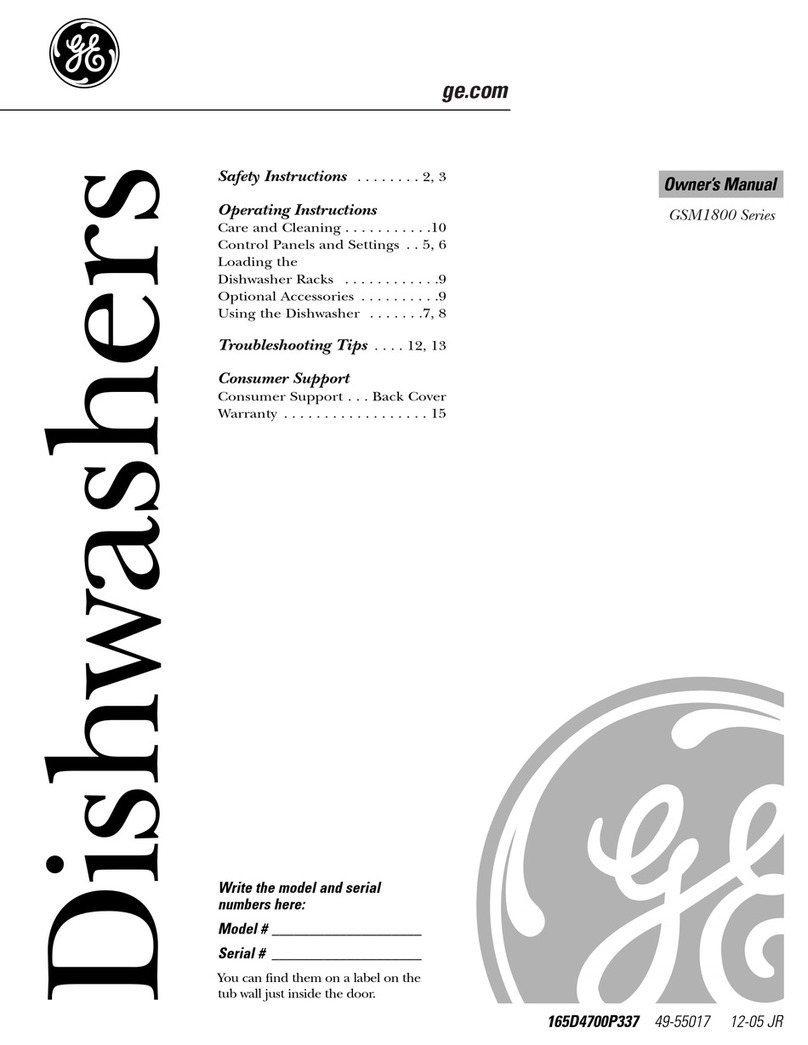
GE
GE GSM1800 Series User manual
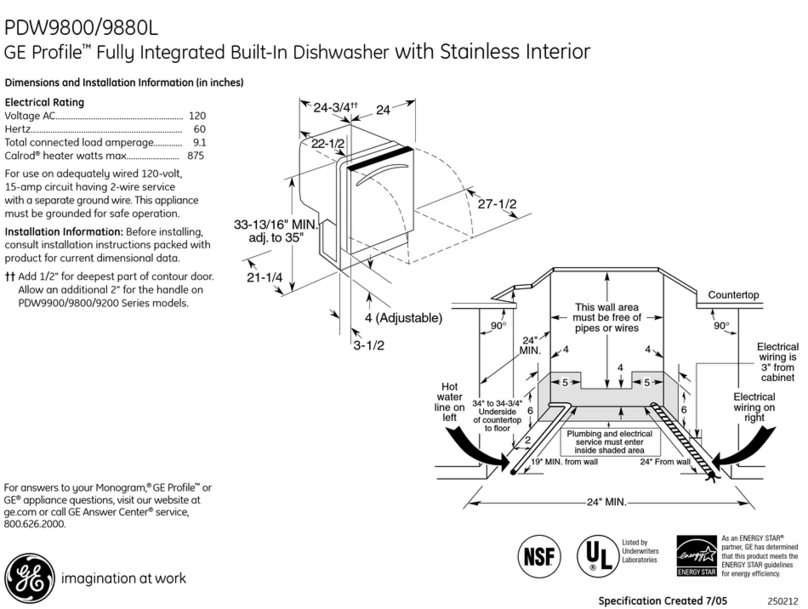
GE
GE Profile PDW9800L Manual

GE
GE HDA3500NCC - Dishwasher w/ 5 Wash Cycles User manual

GE
GE CDT 725-765 Series User manual
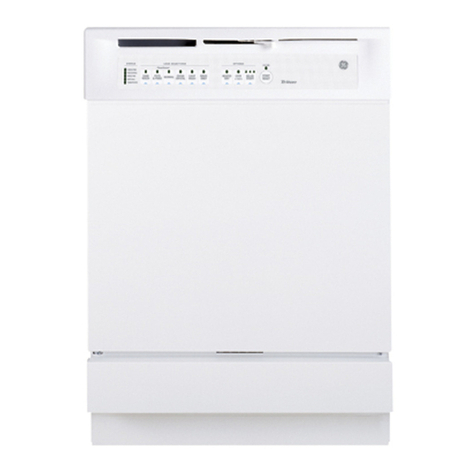
GE
GE Appliances EDW3000 Series User manual
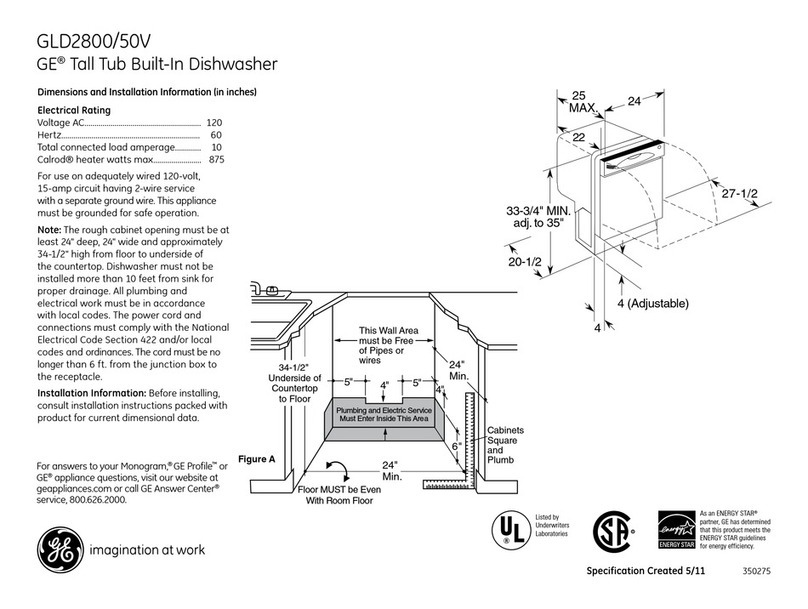
GE
GE GLD2800V Manual

GE
GE HDB727K User manual
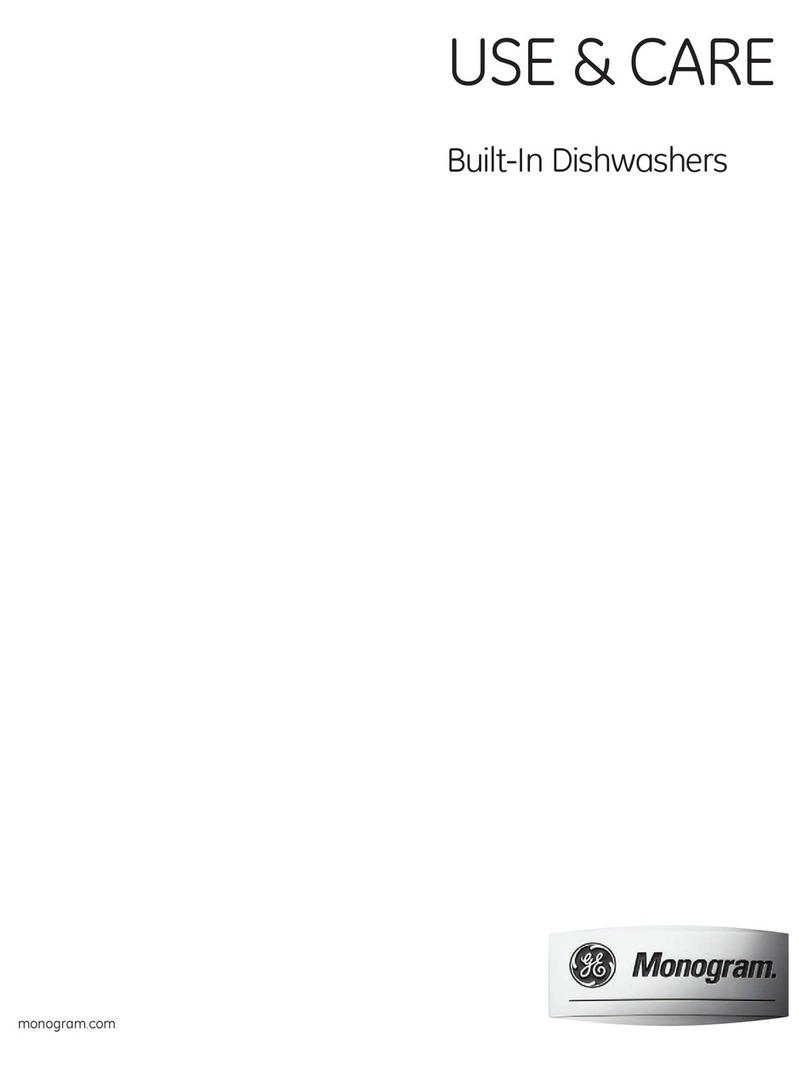
GE
GE Built-In Dishwashers User manual
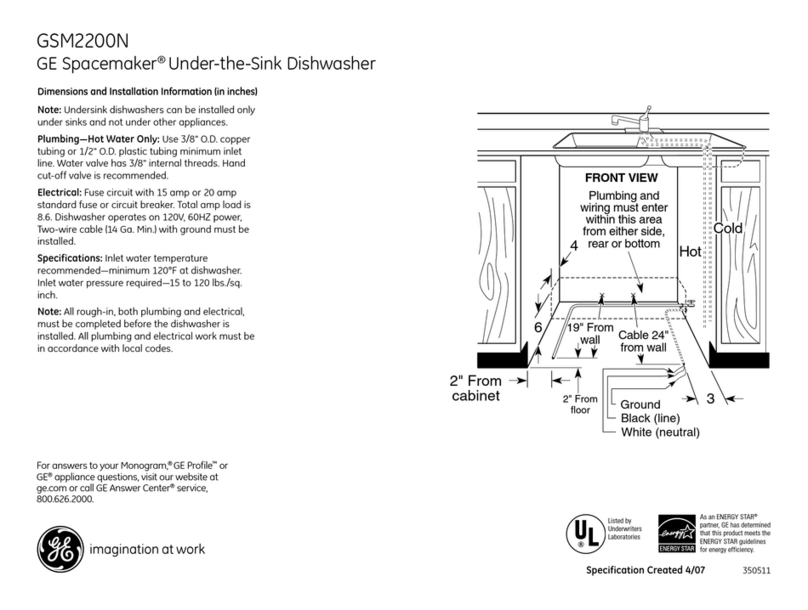
GE
GE Spacemaker GSM2200N User manual

